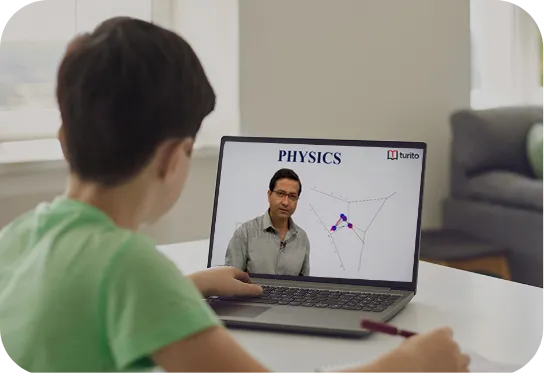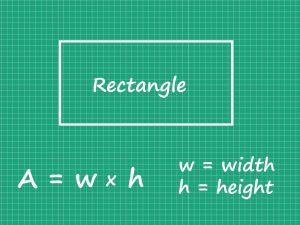Key Concepts
- Understand rotation
- Draw a rotation
- Apply coordinate rules for rotation
- Rotate a figure using coordinate rules
Rotation
Rotation is a transformation in which a figure is turned about a fixed point called the center of rotation. Rays drawn from the center of rotation to a point and their image form the angle of rotation.
A rotation about a point A through an angle of x0 maps every point B in the plane to a point B’ so that one of the following properties is true.
- If B is not the center of rotation A, then BP = B’P and m∠ BPB’= x0 or
- If B is the center of rotation A, then the image of B is B.

Direction of rotation
Rotations can be clockwise or counterclockwise.


Note:
In this chapter, all rotations are counterclockwise.
Draw a rotation
Draw a 1200 rotation of ΔABC about P.

Solution:
Step 1: Draw a segment from A to P.

Step 2: Draw a ray to form a 1200 PA
.

Step 3: Draw A’ so that PA’ = PA

Step 4: Repeat steps 1-3 for each vertex. Draw ΔA′B′C’
Rotations about the origin
If a rotation is shown in a coordinate plane, the center of rotation is the origin.

The diagram shows rotations of point A 130°, 220°, and 310° about the origin. A rotation of 360° returns a figure to its original coordinates.
There are coordinate rules that can be used to find the coordinates of a point after rotations of 90°, 180°, or 270° about the origin.
Coordinate rules for rotations about the origin:
When a point (a, b) is rotated counterclockwise about the origin, the following are true:

- For a rotation of 90°°, (a, b) → (–b, a).
- For a rotation of 180°°, (a, b) → (–a, –b).
- For a rotation of 270°°, (a, b) → (b, –a).
Example:
When a point (3, 4) is rotated counterclockwise about the origin. Find the coordinate after the rotation of 90°, 180° rotation.
Solution:
For a rotation of 90°, (a, b) → (–b, a).
(3,4) → (–4, 3)
For a rotation of 180°, (a, b) → (–a, –b).
(3,4) → (–3, –4)
For a rotation of 270°, (a, b) → (b, –a).
(3,4) → (4, –3)
Rotate a figure using the coordinate rules:
Now, let us use the coordinate rules to rotate a figure in the coordinate plane.
Example 1:
Graph quadrilateral ABCD with vertices A(3, 1), B(5, 1), C(5, –3), and D(2, –1). Then rotate the quadrilateral 270° about the origin.
Solution:
Graph ABCD. Use the coordinate rule for a 270° rotation to find the images of the vertices.

(a, b) → (b, –a)
A(3, 1) → A’(1, –3)
B(5, 1) → B’(1, –5)
C(5, –3) → C’(–3, –5)
D(2, –1) → D’(–1, –2)
Now graph the image A’B’C’D’.

Example 2:
Graph a triangle ABC with vertices A(3, 0), B(4, 3), and C(6, 0). Rotate the triangle 90° about the origin.
Solution:
Graph ABC. Use the coordinate rule for a 90° rotation to find the images of the vertices.
(a, b) → (-b, a)
A(3, 0) → A’(0,3)
B(4, 3) → B’(–3, 4)
C(6, 0) → C’(0, 6)
Now graph the image A’B’C’.

Example 3:
Graph quadrilateral ABCD with vertices A(3, 1), B(5, 1), C(5, –3), and D(2, –1). Then rotate the quadrilateral 180° about the origin.
Solution:
Graph ABCD. Use the coordinate rule for a 180° rotation to find the images of the vertices.

(a, b) → (–a, –b)
A(3, 1) → A’(–3, –1)
B(5, 1) → B’(–5, -1)
C(5, –3) → C’(–5, 3)
D(2, –1) → D’(–2, 1)
Now graph the image A’B’C’D’.

Summary
- Rotation is a transformation in which a figure is turned about a fixed point called the center of rotation. Rays drawn from the center of rotation to a point and their image form the angle of rotation.
- Rotations can be clockwise or counterclockwise.
- If a rotation is shown in a coordinate plane, the center of rotation is the origin.
- When a point (a, b) is rotated counterclockwise about the origin, the following are true:
- For a rotation of 90°,(a, b) + (-b, a).
- For a rotation of 180°,(a, b) + (-a, -b)
- For a rotation of 270°,(a, b) → (b,-a).
Exercise
- Draw a 90° rotation of AABC about A. AB= 3 cm, BC= 4 cm and AC= 5 cm.
- Draw a 180° rotation of AABC about A. AB= 3 cm, BC=4 cm and AC=5 cm
- When a point (8,-3) is rotated counterclockwise about the origin. Find the coordinate after the rotation of 90°, 1800,006) rotation.
- When a point (-1,-4) is rotated counterclockwise about the origin. Find the coordinate after the rotation of 90°, 180°,006 rotation.
- Trace ADEF and P. Then draw a 50° rotation of ADEF about P.

- Graph ARST with vertices R(3,0), S(4,3), and T6,0). Rotate the triangle 90° about the origin.
- Graph ARST with vertices R(3,0), S(4,3), and T6,0). Rotate the triangle 270° about the origin.
- Rotate the figure the given number of degrees about the origin. List the coordinates of the vertices of the image.

- Rotate the figure the given number of degrees about the origin. List the coordinates of the vertices of the image.

- Rotate the figure the given number of degrees about the origin. List the coordinates of the vertices of the image.

Concept Map

What we have learnt
- Understand rotation
- Draw a rotation
- Apply coordinate rules for rotation
- Rotate a figure using coordinate rules.
.
Related topics
Addition and Multiplication Using Counters & Bar-Diagrams
Introduction: We can find the solution to the word problem by solving it. Here, in this topic, we can use 3 methods to find the solution. 1. Add using counters 2. Use factors to get the product 3. Write equations to find the unknown. Addition Equation: 8+8+8 =? Multiplication equation: 3×8=? Example 1: Andrew has […]
Read More >>Dilation: Definitions, Characteristics, and Similarities
Understanding Dilation A dilation is a transformation that produces an image that is of the same shape and different sizes. Dilation that creates a larger image is called enlargement. Describing Dilation Dilation of Scale Factor 2 The following figure undergoes a dilation with a scale factor of 2 giving an image A’ (2, 4), B’ […]
Read More >>How to Write and Interpret Numerical Expressions?
Write numerical expressions What is the Meaning of Numerical Expression? A numerical expression is a combination of numbers and integers using basic operations such as addition, subtraction, multiplication, or division. The word PEMDAS stands for: P → Parentheses E → Exponents M → Multiplication D → Division A → Addition S → Subtraction Some examples […]
Read More >>System of Linear Inequalities and Equations
Introduction: Systems of Linear Inequalities: A system of linear inequalities is a set of two or more linear inequalities in the same variables. The following example illustrates this, y < x + 2…………..Inequality 1 y ≥ 2x − 1…………Inequality 2 Solution of a System of Linear Inequalities: A solution of a system of linear inequalities […]
Read More >>Other topics











Comments: